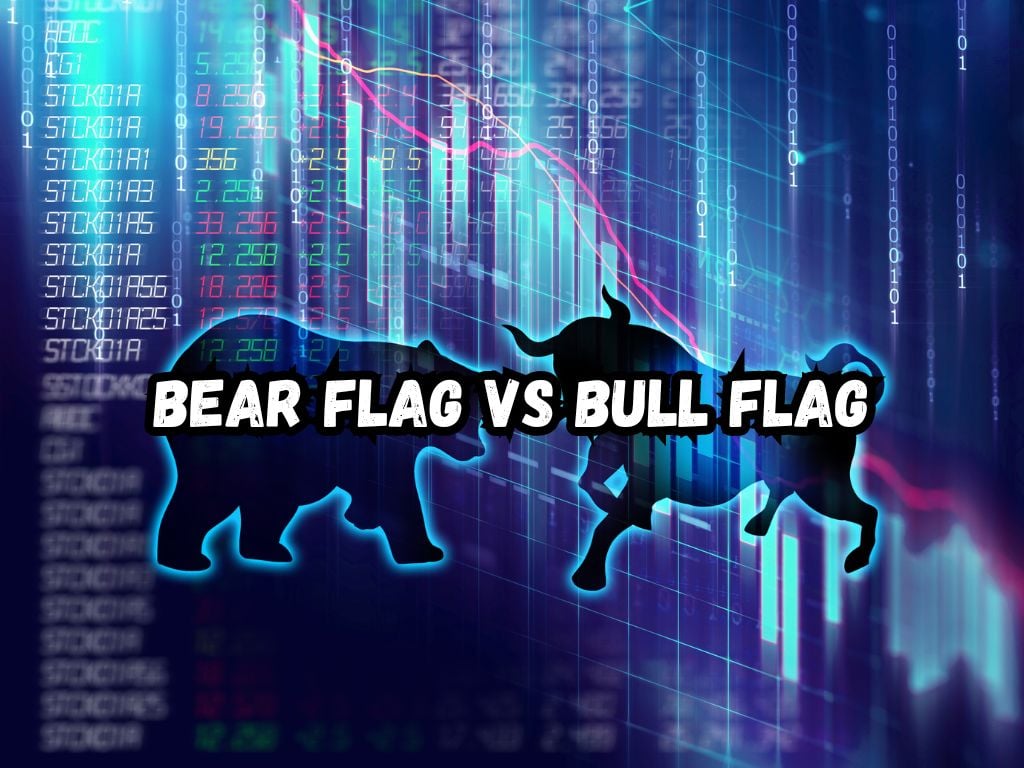Trading is a domain enriched with patterns, each a storyteller of potential future moves. As a trader, your ability to interpret these patterns can set you apart, granting you a competitive edge.
Bear and bull flags are particularly telling, reflecting continuation patterns that may predict price extensions in either direction. Grasping bear flag vs bull flag difference is foundational for any serious market participant.
What Are Bear and Bull Flags?
A bear flag embodies a downtrend continuation pattern. It’s like a brief interlude in an ongoing bearish storyline, where prices consolidate before resuming their descent.
Picture a flagpole formed by a swift price drop followed by a parallel price channel moving counter to the trend. This flag formation whispers of bears still prevailing over the bulls, suggesting a likely continuation downward.
In contrast, a bull flag, the optimistic counterpart, symbolizes an uptrend continuation. It emerges during a rally when prices pause to catch their breath, creating a smaller inverted symmetrical channel or a downward sloping rectangle that tilts against the prevailing bullish trend.
Envision this as the market drawing back a bowstring before sending the price arrow forth, indicating a probable surge ahead.

How to Identify Bear and Bull Flags?
Discerning these flags hinges on recognizing specific structures within the price action. For bear flags, look for a precipitous price fall leading to the flagpole, followed by a rebound that forms the flag.
This rebound will feature highs and lows converging, confined within two parallel lines resembling a flag. The bear flag is awaiting its next plunge. Identifying bull flags involves spotting a sharp price increase that serves as the flagpole.
The consolidation that forms the flag will typically have lower highs and lower lows, also within a channel against the trend. Imagine the market slightly recoiling before it leaps forward again.
Bear Flag vs Bull Flag: Trading Strategies
When a bear flag unfurls, traders brace for action. Short-selling upon the breakout below the flag provides a favored strategy.
Conversely, upon observing a bull flag, traders may anticipate buying at the breakout point over the flag’s resistance. Keen observation and timing are paramount in executing these strategies effectively.
Traders must also beware of false breakouts — a common pitfall. Confirming a breakout with volume can ward off such deceptive moves, honing the strategy’s precision. A breakout with substantial volume is akin to a confident affirmation from the market, bolstering the signal’s credibility.
Case Studies or Historical Examples
History has consistently echoed the significance of these patterns. Take, for example, a renowned stock that showcased a classic bear flag pattern in 2008 during the financial crisis.
After an initial sharp drop, the stock’s price consolidated, raising a flag that was met with apprehension. Not long after, as predicted by the bear flag, the prices cascaded downward, a script in line with the pattern’s narrative.
On the bull side, technology stocks often present textbook bull flags. An agile stock in this sector may leap to new heights, then form a bull flag as traders bank profits and the stock subtly retreats. This pause invariably leads to a robust price spike, exemplifying the bull flag prophecy.
Pro Tips for Trading Bear and Bull Flags
Mastering trade in bear and bull flags involves more than mere pattern recognition. One professional tip is to define exit and entry points based on the height of the flagpole.
Managing risks by setting stop losses just outside the flag can limit potential damage if the market swings contrarily.

Technical Indicators to Complement Bear and Bull Flags
When studying bear and bull flag patterns, incorporating other technical indicators can enhance the robustness and reliability of your trading strategy.
Moving averages, RSI (Relative Strength Index), and MACD (Moving Average Convergence Divergence) are key tools that, when used in tandem with flag patterns, confirm trends and strengthen trade signals.
Moving averages can smooth price data to form a single flowing line, making it easier to identify the overall direction of the trend.
For instance, a flag pattern that forms above a significant moving average, like the 50-day or 200-day, may suggest a stronger bullish sentiment, reinforcing the credibility of a bull flag. Conversely, a bear flag occurring below these moving averages could signal continued bearish trends.
The RSI, a momentum oscillator, measures the speed and change of price movements on a scale from 0 to 100. An RSI level above 70 indicates a potentially overbought condition, while below 30 suggests an oversold condition.
For flag patterns, an approaching overbought condition might precede a bear flag’s breakdown, whereas nearing oversold conditions could anticipate a bull flag’s breakout.
MACD, a trend-following momentum indicator, shows the relationship between two moving averages of a security’s price. The MACD crossing above its signal line may suggest bullish momentum, complementing a bull flag breakout.
A cross below the signal line can indicate bearish momentum, aligning with a bear flag breakdown. Together, these indicators provide a multifaceted view of the market, offering traders a more comprehensive analysis when evaluating bear and bull flag patterns.
Frequently Asked Questions
Is a bear flag always a downtrend continuation?
While often true, bear flags can sometimes be the prelude to a reversal if other market conditions align.
Can bull flags appear in bear markets?
Certainly, as bear markets may experience rallies countering the dominant downtrend — these are prime environments for bull flags to surface.
How reliable are flag patterns in cryptocurrency trading?
Crypto markets, with their volatility, still adhere to classical trading patterns, including bear and bull flags, making them creditable signals even in digital assets trading.
Conclusion
Delineating bear from bull flags is an art that, once honed, can be incredibly rewarding. These flags signal the market’s intended trajectory, giving traders valuable foresight.
With prudent strategies, an eye for detail, and a good grasp of market dynamics, traders can harness the power of bear and bull flags to navigate the markets more adeptly.
While no pattern guarantees success, bear and bull flags are tools of immense value in a trader’s analytical arsenal. Stand ready at the helm, for the flags are fluttering, and the market awaits your savvy command.


 Tags:
Tags:










